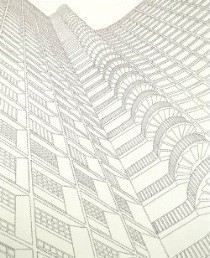
Paulo Climachauska, COPAN, 2004 © Paulo Climachauska
The 1st at Moderna: Paulo Climachauska
Moderna Mirror
1.12 2004 – 17.4 2005
Stockholm
Paulo Climachauska´s wall drawings are often portraits of the building in which they are drawn. The most recent example is his work for the 2004 São Paulo Biennial, where he used one of the walls of the biennial pavilion (designed by Oscar Niemeyer in 1954) to create an inverted portrait of the characteristic, organic story structure of the building.
Tyghuset is not really a part of Moderna Museet but appears to be so when seen through the large windows. The most distinguishing feature of Paulo Climachauska’s wall drawings is neither their size nor their subject matter but the fact that the drawings are constructed entirely of subtractions, which is only revealed on close inspection. Each line consists of a number of figures that are subtracted until the sum is zero. As a viewer, one is first struck by the effort, precision and brainwork that have gone into the drawing.
Paulo Climachauska’s intention, however, is not to impress or excel in mathematical constructions. His message is explicitly political and his subtractions carry a wish for a new social order. He proposes a different economical and political system, built on subtraction rather than addition. Paulo Climachauska’s art conveys the idea that we would benefit not by maximising but by reducing, cutting down and minimising. Our lives can have a richer content without us having to become materially richer.
The subtractions are also a comment on Brazil’s dynamic modernist heritage. The wall drawings that Paulo Climachauska has created in Brazil often depict the large modernist buildings for which the country is famous. This kind of ‘tropical modernism’, mainly by Brazil’s uncrowned king of architecture, Oscar Niemeyer (born in 1907 and still active), has put its mark on the country ever since its capital Brasilia was founded in 1956, with Niemeyer as chief architect. Since then, his buildings have spread across Brazil. They are often extensive and can be characterised as the country’s showpiece buildings. A typical example is the apartment complex Copan in central São Paulo, South America’s largest concrete building. Paulo Climachauska reduces the importance of these buildings by drawing them with subtractions.
Paulo Climachauska
Paulo Climachauska was born in 1962 in São Paulo, Brazil, where he still lives and works. He has an academic degree in history and is an autodidact artist. During the past ten years he has taken part in around 50 group exhibitions and has had around ten solo exhibitions.
Latest solo exhibitions, selection
2004 Projeto Parede. Museu de Arte Moderna, São Paulo
2003 Project 01. Park Gauflstrafle, Hamburg
Galeria André Millan, São Paulo
2002 Cavalaricas, Parque Lage, Rio de Janeiro
Latest group exhibitions, selection
2004 26a Bienal de São Paulo
14a Bienal de San Juan, Puerto Rico
8a Bienal de Cuenca, Ecuador
Estratégias Barrocas, Centro Metropolitano de Quito, Ecuador
Curator: Camilla Carlberg
The 1st at Moderna is an exhibition programme for contemporary art. The opening is always on the first day of the month, and the exhibitions are in different venues in or outside the museum.
